



Milk Product Prices Fall - FAO Global Outlook
Milk and milk product prices fall in the face of increased availability on the international market, according to the FAO Global Food Outlook.International prices of dairy products began to decline in
mid-2011, as supplies to the international market improved.
During the five-month period October 2011 to February
2012, the FAO international dairy products price index
(2002–2004=100) stayed within a narrow range of 200 to
207. In March, prices registered a sharp decline, reflecting
the favourable conclusion of the Southern Hemisphere
milk producing season and an equally positive opening of
the Northern Hemisphere season. Prices have weakened
for all the products that constitute the index. Comparing
April 2012 with a year earlier, butter was down USD 1 250
per tonne, or 26 percent, while whole milk powder fell by
USD 794 per tonne, or 19 percent. Skimmed milk powder
registered a fall of USD 744 per tonne, or 20 percent, while
cheddar cheese dropped by USD 725 per tonne, or 16
percent. The price slide reflected a rise in export availability
and a fall in the value of the euro against the US dollar.
Yet despite the drop, international prices for dairy
products still remain well above historical averages. With
publicly financed inventories at minimal levels in the EU and
the United States, the market remains sensitive to sudden
changes in milk production and availability of milk products.
The positive supply outlook for the rest of 2012 is likely to
mean further downward pressure on prices.
FAO International Dairy Price Index (2002-2004=100)
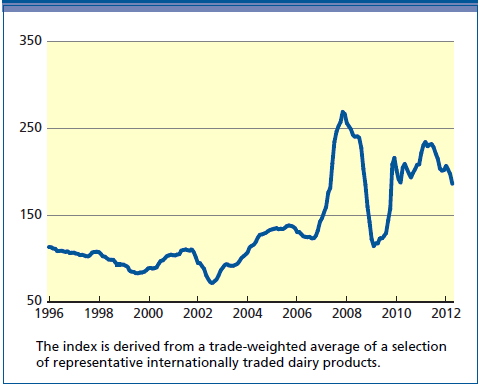
World Dairy Market at a Glance
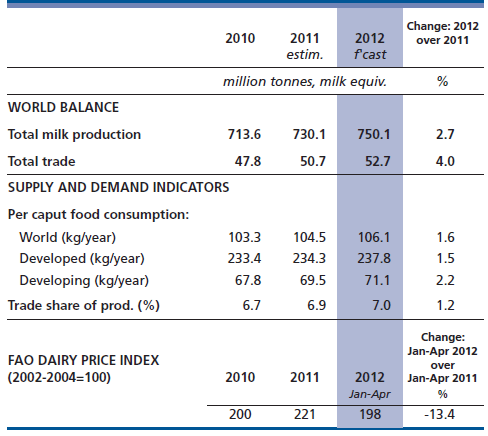
PRODUCTION
Milk production continues to grow, especially in Asia, Oceania and South America
World milk production in 2012 is forecast to grow by 2.7
percent to 750 million tonnes. Asia is expected to account
for most of the increase, with output in India, the world’s
largest milk producing country, forecast to rise by 5.2 million
tonnes to 127 million tonnes. Dynamic domestic demand
is the main engine stimulating growth, as India is largely
absent from the international market for dairy products.
Increased output is also anticipated in China, Pakistan and
Turkey, as consumer demand continues to rise.
In Africa, a small increase in milk output is anticipated for
2012. For example, milk production is Kenya is expected to
recover somewhat, due to favourable rains in October and
March that improved pasture conditions in drought-affected
areas – which are expected to last until at least mid-2012;
however, a shortage of some types of feed remains a constraint. High maize prices are expected to constrain
growth in milk production in South Africa in 2012, leaving
it unchanged. Elsewhere in the region, an outbreak of footand-
mouth disease in Egypt has led to higher calf morality
and may depress milk output.
Rising incomes and strong international prices have
favoured production growth in several countries in Latin
America and the Caribbean. Most South American countries
had very good pasture conditions during the 2011/2012
production year. Overall, South American milk production
grew by 4.4 percent during the 2011 calendar year to reach
68 million tonnes, registering strong gains in Argentina,
Ecuador and Uruguay, with a similar magnitude of increase anticipated for 2012. As international prices have remained
relatively high by historical standards, good returns on
overseas sales have allowed greater use of concentrated
feed, further increasing milk yields per animal. The largest
producer, Brazil, is also forecast to increase milk output
this year, even though some regions suffered from drought
during 2011 which has affected pasture condition. Output
in Chile may be curbed in 2012, due to a dry end to the
2011/2012 season associated with a la niña weather
phenomenon which adversely affected both pasture
condition and feed availability. In Central America, output
from the main producing countries, including Mexico and
Costa Rica, is expected to be largely stable.
In North America, milk production in the United States
is forecast to rise to 90.6 million tonnes, reflecting dairy herd
expansion in response to positive national and international
demand. Production in Canada is expected to remain stable at
8.3 million tonnes, within the limits set by the milk quota system.
In Europe, the EU is forecast to raise production by 1
percent to 156.5 million tonnes in 2012, as improved milk
yields more than compensate for reduced cow numbers.
Additionally, spring weather has been favourable for pasture
growth and the new milk production season has started
positively. Production limits are being raised by 1 percent
per year in the EU, in preparation for the abolition of the
quota system in 2015. Milk production in the Russian
Federation is anticipated to rise as a result of falling feed
prices and herd rebuilding, follow a sharp contraction in
the dairy herd during the drought of 2010. In neighbouring
Ukraine, milk production may stabilize, following a period
of prolonged decline, due to government programmes to
support the sector and lower feed prices. In Oceania, a
prolonged period of high prices for dairy products on the
international market and associated levels of profitability
have stimulated milk production. In New Zealand, output
rebounded strongly during the 2011/12 season, stemming
from an increase in herd size combined with above average
pasture conditions, and is expected to close 9 percent above
the previous season. In Australia, the end of the prolonged
drought has encouraged farmers to rebuild their dairy herds
which, combined with generally good rainfall during the
2011/12 season, could boost milk production by 4 percent.
TRADE
A favourable outcome of the season in Oceania and South America drives international prices down
World trade in dairy products is expected to continue to
expand in 2012. Demand remains firm and imports are forecast to reach 52.5 million tonnes of milk equivalent.
In recent months, prices have been affected by two main
factors: a fall in value of the euro against the US dollar that
began in mid-2011, and more recently, a strong finish to the
Southern Hemisphere production season. The current market
sentiment finds importers delaying placing orders in order to
see if prices drop further.
Asia will continue to be the main market, with additional
demand expected to come from countries such as China,
Saudi Arabia, Indonesia, the Republic of Korea and
Singapore. Elsewhere, imports by Egypt may also grow,
as could purchases by the two principal purchasers in Latin
America, Mexico and Venezuela. However, imports by
third-placed Brazil may decrease, due to rising domestic
milk production. Strong increase in availabilities from
pasture-based production in Argentina, New Zealand and
Uruguay may stimulate their exports to rise by 12 percent,
8 percent and 5 percent respectively. The other principal
trading countries – Australia, Belarus, the EU and the
United States – are anticipated to maintain sales levels
similar to 2011.
WHOLE MILK POWDER (WMP)
International WMP prices were largely unchanged from August 2011 to February 2012, at around USD 3 575 per tonne. In the Southern Hemisphere, the strong closing of the 2011/2012 season resulted in larger than expected availability in March and April. As a consequence, prices fell, with April WMP trading some USD 280 lower at USD 3 295 per tonne. World exports of WMP are projected to show continued growth in 2012, rising by 124 000 tonnes to reach 2.4 million tonnes. Sustained demand is forecast for Asia, the main market, as well as for importers in North Africa, the Middle East and Latin America. China, Egypt, Algeria and Venezuela, the major importing countries (in order of volume of trade) make up 40 percent of world WMP trade. All four countries are expected to increase purchases in 2012, as are other important importing countries such as (in order of volume of trade) Saudi Arabia, United Arab Emirates, Singapore, Sri Lanka, Indonesia and Oman. Conversely, imports by Brazil and Nigeria may decline. Demand for WMP is very geographically diverse, due to its wide use in both the processing industry and for direct retail sale. As for exporters, Argentina, Australia and New Zealand will supply most of the increase in trade, as supply limitations and more profitable alternative uses are expected to curb exports from the EU. These four exporters supply 80 percent of the international WMP market.
EU Intervention Prices, Price and Export Refund for Butter and Skim Milk Powder
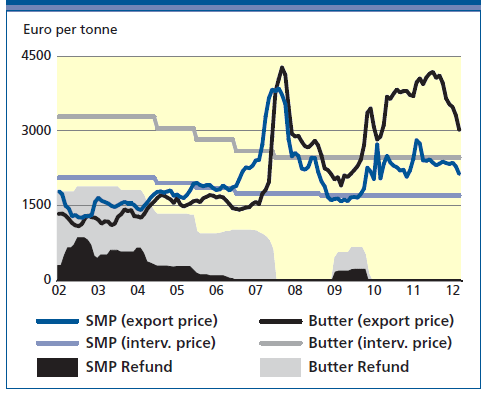
SKIM MILK POWDER (SMP)
Trade in SMP is anticipated to rise by 3 percent in 2012, to 1.8 million tonnes. SMP prices were relatively stable during the final months of 2011 and in January of 2012, hovering around the USD 3 400 mark and reflecting a balanced market overall. Subsequently, average prices dropped each month between February and April to stand at USD 3 025 SMP is central to the milk processing industry in many countries and, as such, market demand is widespread. The principal markets are (in order of volume) Mexico, China, Indonesia, the Philippines, Algeria and Malaysia, followed by Thailand, Singapore, Saudi Arabia and Egypt. Overall demand is expected to remain firm in these markets. China, in particular, is anticipated to increase its purchases substantially, by 20 000 tonnes, and is on course to become the major importer of SMP by the middle of the decade: China became the major importer of WMP in 2010. Increased imports are also anticipated (in order of volume) for Mexico, Indonesia, the Philippines and Malaysia. Conversely, purchases by Algeria, fifth ranked in terms of volume, may decrease as the government seeks to promote domestic milk production. Slightly over three-quarters of world exports are supplied by (in order of volume) the EU, the United States and New Zealand. For 2012, the largest increase in supplies is expected to come from New Zealand, with strong growth also foreseen for fellow pasture-based milk producers, Uruguay and Argentina. The United States is also expected to increase its sales, as milk production is growing and the export of SMP is the principal vehicle for balancing its domestic dairy market. Conversely, better returns from cheese production may cause EU export availabilities to decline by about 3 percent. At the same time, as in the case of the United States, SMP exports play an important role in maintaining balance in the EU milk market, as overall internal demand is biased towards milk fat for butter and cheese production, rather than milk protein.
Major Exporters of Dairy Products
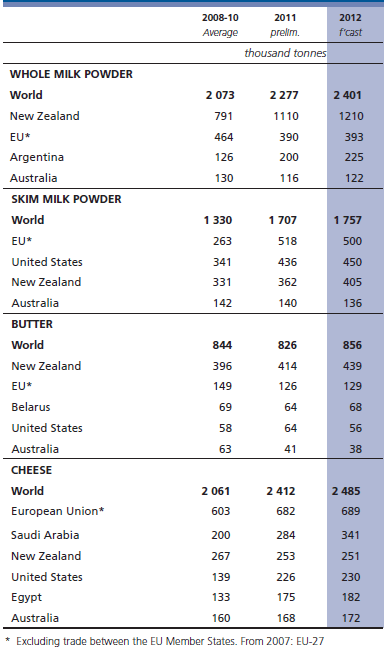
BUTTER
In tandem with its co-product, SMP, butter prices fell sharply in February and March during the February to April period, dropping by USD 400 to stand at USD 3 500 per tonne. Trade in butter is forecast to grow by 3.7 percent in 2012, to 856 000 tonnes. This is anticipated to be a consequence of increased deliveries by New Zealand, Belarus, Argentina and, to a lesser extent, the EU, more than compensating for a fall in sales from the United States and Australia. In the case of the EU, lower profitability for butter has led to more emphasis on using milk for cheese production. Demand for butter imports comes principally from Southeast Asia, the Middle East and the Russian Federation and is expected to remain firm.
FAO Indices of Dairy and Feed Prices (2002-2004=100)
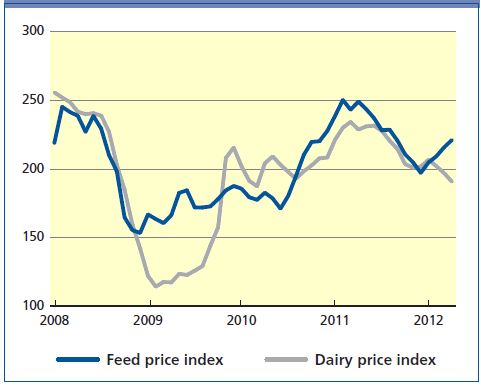
CHEESE
Among the dairy commodities, cheese prices have traditionally been more stable – reflecting the wide variety of cheese available, each with its own distinct characteristics, making it less subject to the same degree of supply and demand fluctuation as the standardised products, such as milk powder or butter. For most of 2011, cheese prices (cheddar) stayed within the range USD 4 400 to USD 4 500 per tonne. However, in October, they began to follow other dairy products downwards, and have remained around USD 4 000 per tonne since until March. In April, prices registered a further fall, to USD 3700. Trade in cheese is forecast to grow by 3.1 percent in 2012, to 2.5 million tonnes, sustained by robust import demand. The world cheese market is the most difficult dairy market to classify. One apparent anomaly is that a number of major cheese producing and exporting countries are also important importers, including (in order of volume) the United States, Australia, the EU and Switzerland. Most often, purchases by this group of countries reflect import quotas under trade agreements and also the highly specific nature of some cheeses, including those with restrictions on the use of their names and areas of origin. Elsewhere, several of the most important cheese importers, including the Russian Federation, Japan, Egypt, Saudi Arabia, the Republic of Korea and Mexico, focus more on industrial cheese, both for direct consumption and for use by the processing industry. The EU remains the major cheese exporter, accounting for almost 30 percent of world trade, which does not include the substantial amount of cheese that is traded among the EU countries themselves. Other important exporters are Saudi Arabia, New Zealand, the United States, Egypt, Australia, Belarus, Ukraine, Argentina, Switzerland, Uruguay and Turkey.
May 2012


